Frontiers of the Roman Empire - The Lower German Limes in the Netherlands: Somewhere between 19 and 12 BCE, the first Roman legionary camp was built near Nijmegen. Forty years after the first Roman campaign, general Drusus managed to bring the countries to the south of the river Rhine under Roman control. Military camps were built along the Rhine, they served as a base for campaigns to the north and probably to conquer Great Britain. The northern frontier of the Roman Empire, the Limes, ran in 47 CE along the Rhine, roughly formed by the rivers Nederrijn, Kromme Rijn, Leidsche Rijn and Oude Rijn. In the first century, a chain of castella, Roman forts, were built along the Rhine, these forts were smaller than the huge legionary fortress at Nijmegen. Until the end of the first century CE, the region remained under Roman military control. Somewhe between 82 and 90 EC, it became a province of the Roman Empire, named Germania Inferior, Lower Germany. Later, it was renamed Germania Secunda. Germania Inferior encompassed the Netherlands south of the Rhine, the eastern part of Belgium, a part of northeastern France, Luxembourg and the German Rhineland up to the river Vinxtbach near Bonn. The capital city of Germania Inferior was Colonia Agrippinensium, modern Cologne in Germany. Germania Inferior survived until it was conquered by the Franks in the fourth century. The principal settlements of Germania Inferior in the Netherlands were: Coriovallum (Heerlen), Albaniana (Alphen aan den Rijn), Lugdunum Batavorum (Katwijk), Forum Hadriani (Voorburg), Ulpia Noviomagus Batavorum ( Nijmegen), Traiectum (Utrecht). In the Netherlands, the Roman Limes stretches along the river Rhine, from the German border, through the municipality of Zevenaar, Arnhem, Utrecht, and Leiden, to the North Sea coast near Katwijk aan Zee. Today, many traces of the Roman presence can still be found in the Netherlands. Several museums exhibit Roman artifacts, such as the Valkhof Museum in Nijmegen. A number of objects found during the excavations of Fort Fectio are on display in one of the rooms of Fort bij Vechten. In the Netherlands, nineteen locations of the Frontiers of the Roman Empire - The Lower German Limes - were declared a UNESCO World Heritage in 2021.
www.werelderfgoedfotos.nl © Copyright World Heritage Photos
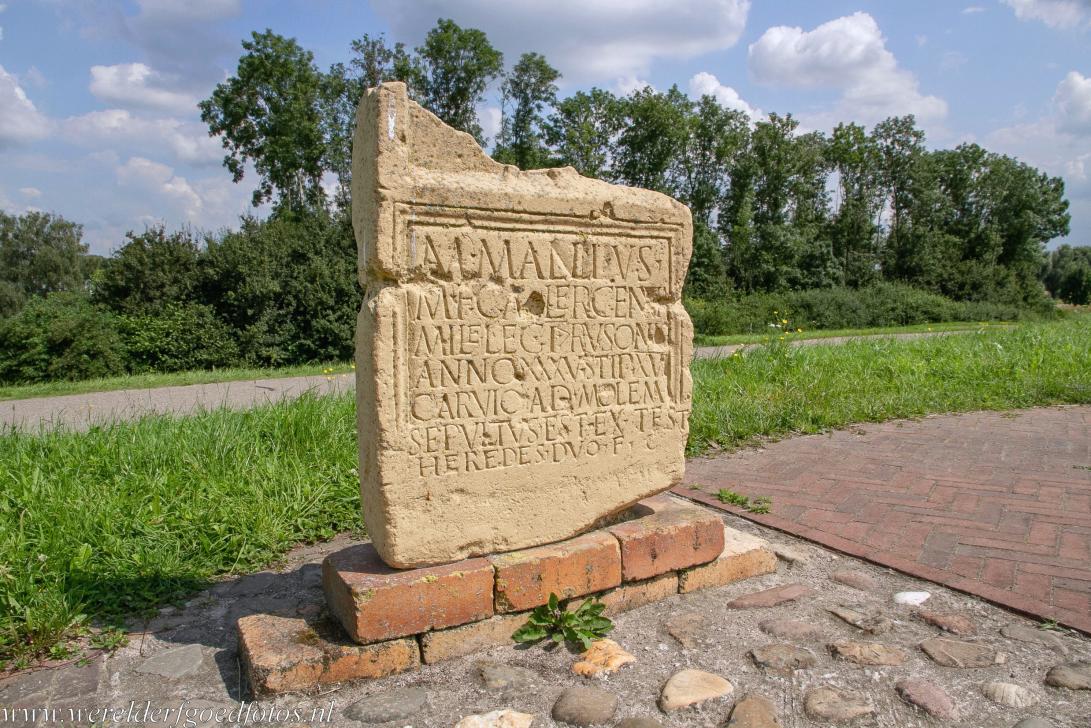
Frontiers of the Roman Empire - The Lower German Limes in the Netherlands: A replica of the gravestone of Marcus Mallius at Herwen, a tiny Dutch village near the German border. Marcus Mallius was a Roman soldier of the First Legion. The original gravestone was found at Herwen in 1938, it is now on display at the Valkhof Museum in Nijmegen. At Herwen once stood the Roman fort Castellum Carvium, it was located in strategic location at the junction of the Waal and Rhine rivers, the remains of the fort are probably at the bottom of the sand mining pit lake the Bijland.

Frontiers of the Roman Empire - The Lower German Limes in the Netherlands: A replica of the gravestone of Marcus Mallius at Herwen, a tiny Dutch village near the German border. Marcus Mallius was a Roman soldier of the First Legion. The original gravestone was found at Herwen in 1938, it is now on display at the Valkhof Museum in Nijmegen. At Herwen once stood the Roman fort Castellum Carvium, it was located in strategic location at the junction of the Waal and Rhine rivers, the remains of the fort are probably at the bottom of the sand mining pit lake the Bijland.
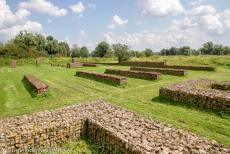
Frontiers of the Roman Empire - The Lower German Limes in the Netherlands: Visualisation of the headquarters of the Roman fort at Meinerswijk near Arnhem. The Roman fort at the Nature Reserve Meinerswijk was discovered in 1979 and was excavated at the beginning of the 1990s. Archeologists concluded that this Roman fort must have been Castra Herculis, the fort was built between 10 CE and 20 CE. Castra Herculis is one of the oldest Roman forts in the Netherlands, it guarded the Roman border near the confluence of the IJssel and Lower Rhine rivers.
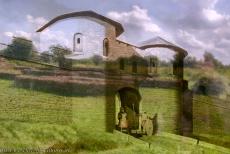
Frontiers of the Roman Empire - The Lower German Limes in the Netherlands: A glass plaque at the Roman fort Castra Herculis at Meinerswijk depicting the Porta Decumana, the back gate. During the Batavian Revolt in 70 CE, the wooden fort was destroyed by the Batavi, an ancient German tribe. In the 2nd century, the Romans rebuilt the fort in stone. The only part of Castra Herculis to have been excavated in 1979 were the remains of the principia, the headquarters. The remains of the southern wall and the Porta Decumana were discovered in 1991 and 1995.
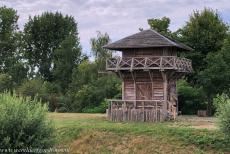
Frontiers of the Roman Empire - The Lower German Limes in the Netherlands: The Roman Watchtower De Spees near Kesteren is a copy of one of the many Roman Watchtowers in the Betuwe, a historical region in the Netherlands between the rivers Rhine and Waal. The Roman Watchtower De Spees is one of the many watchtowers that lined the borders, the Limes, of the Roman Empire. In the Low Countries, the northern frontier of the Roman Empire ran in 47 CE along the Rhine, roughly formed by the Nederrijn, Kromme Rijn, Leidsche Rijn and Oude Rijn.
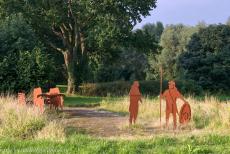
Frontiers of the Roman Empire - The Lower German Limes in the Netherlands: The remains of a Roman road between the villages of Elst and Driel. The road was once part of a Roman highway that connected Ulpia Noviomagus Batavorum (Nijmegen) and the Roman forts along the Rhine, such as the fort at Meinerswijk near Arnhem. Roman roads were paved with fieldstones, gravel or shells, ditches were dug along the edge of the road for drainage. The Romans used the roads primarily for military reasons, but merchants and citizens also used the roads.

Frontiers of the Roman Empire - The Lower German Limes in the Netherlands: A reconstruction of the foundations of Fort Fectio, a Roman castellum at Bunnik, a village near the city of Utrecht. Fort Fectio was the largest roman castellum in the Netherlands, and after the castra at Nijmgen, the oldest Roman caslellum in the Netherlands. The huge castellum could house over thousand people. In the 19th century, around 10,000 artifacts were excavated at Fort Fectio. Most of the objects are housed in the Centraal Museum in Utrecht.
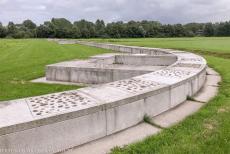
Frontiers of the Roman Empire - The Lower German Limes in the Netherlands: Fort Fectio was a Roman fort, built in a strategic location where the river Vecht once started as a branch of the Rhine. Fort Fectio was probably built on the order of Tiberius, the second Roman emperor. The wooden fort was destroyed during the Batavian Revolt, the rebellion of the Batavians against the Romans in 69-70 CE. Fort Fectio was rebuilt from brick and fieldstone. Around 200 CE, the fort was no longer accessible by water. The Romans abandoned the fort between 270- 275 CE.

Frontiers of the Roman Empire - The Lower German Limes in the Netherlands: Visualisation of Fort Fectio, in the background a reconstruction of a Roman watchtower. Fort Fectio was a huge Roman castellum (fort), built in the early years of the first century CE. A modern reconstruction of the foundations is situated next to Fort bij Vechten, one of the largest forts of the New Dutch Water Line. Several objects found during the excavations of Fort Fectio are on display in one of the rooms of Fort bij Vechten.

Frontiers of the Roman Empire - The Lower German Limes in the Netherlands: The remains of the Pillar of the Gods are on display in the Valkhof Museum in Nijmegen, the pillar was erected in the 1th century CE to commemorate the Roman victory over Germanic tribes. The remains, two limestone blocks, were excavated in front of the Valkhof Museum in Nijmegen. The pillar is adorned with sculpted reliefs of Roman gods and people. Noviomagus is a work of art, inspired by the Pillar of the Gods (Godenpijler), it stands in front of the Valkhof Museum.
